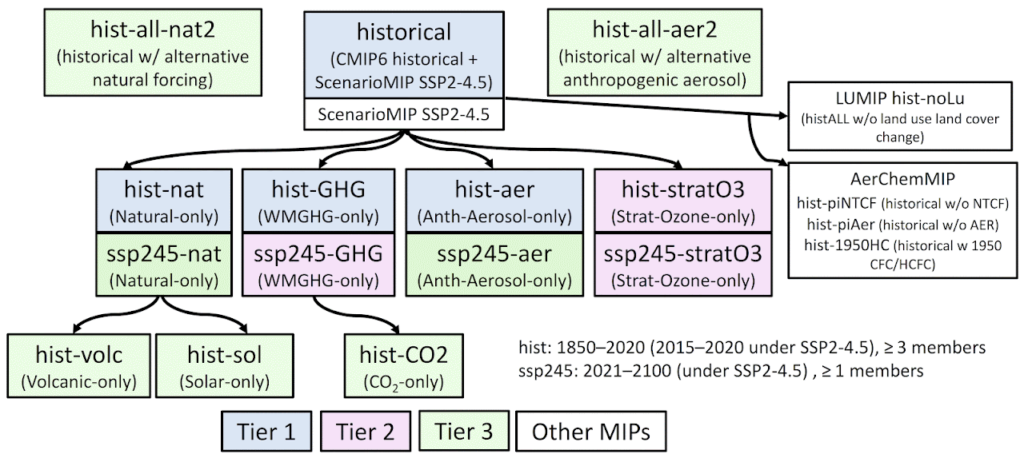
On this Page
The Detection and Attribution Model Intercomparison Project (DAMIP) is part of the Coupled Model Intercomparison Project Phase 6 (CMIP6), a coordinated international effort “to better understand past, present and future climate changes arising from either natural, unforced variability or in response to changes in radiative forcing in a multi-model context.”
DAMIP is the component of CMIP6 dealing with understanding the individual contributions of various external factors to past and future changes in global and regional climate.
The primary goals of DAMIP are to facilitate improved estimation of the contributions of anthropogenic and natural forcing changes to observed global warming as well as to observed global and regional changes in other climate variables; to contribute to the estimation of how historical emissions have altered and are altering contemporary climate risk; and to facilitate improved observationally-constrained projections of future climate change.
Key Publications
- The Detection and Attribution Model Intercomparison Project (DAMIP v1.0) contribution to CMIP6. (Gillett et al., 2016)
- Designing detection and attribution simulations for CMIP6 to optimize the estimation of greenhouse gas-inducing warming. (Ribes et al., 2015)
- Modifying emission scenario projections to account for the effects of COVID-19: protocol for Covid-MIP (Lamboll et al., 2020)
Status and Data
As of July 2023, 23 climate models have output submitted for DAMIP experiments. Up-to-date information on which models have submitted data can be found by following this link. Information about issues with the simulations and output data can be found by searching the Errata system. Guidance on using Errata can be found here.
Output data can be downloaded from the ESGF/CoG portal here.
DAMIP Experiments
Detection and attribution (D&A) studies typically require unforced control simulations and historical simulations including all major anthropogenic and natural forcings. Such simulations will be carried out as part of the CMIP6 DECK and the CMIP6 historical simulation. In addition D&A studies require simulations covering the historical period driven by individual forcings or subsets of forcings only: these will be undertaken as part of DAMIP. Key novel features of the DAMIP experimental design following D&A-relevant simulations in CMIP5 are:
- new historical simulations of aerosols-only, stratospheric-ozone-only, CO2-only, solar-only, and volcanic-only forcing, facilitating an improved estimation of the climate response to individual forcing;
- future single forcing experiments, allowing observationally-constrained projections of future climate change;
- an experimental design which allows models with and without coupled atmospheric chemistry to be compared on an equal footing.

See the tables below for a full list of the DAMIP experiments. These tables can be viewed full screen by clicking this link.
Scientific Steering Committee
| Name | Affiliation | Role | Contact |
|---|---|---|---|
| Nathan Gillet | CCCma, Canada | Co-chair | nathan.gillett@canada.ca |
| Isla Simpson | NCAR, USA | Co-chair | islas@ucar.edu |
| Gabriele Hegerl | University of Edinburgh, UK | Member | |
| Reto Knutti | ETH Zürich, Switzerland | Member | |
| Aurelien Ribes | CNRM, France | Member | |
| Hideo Shiogama | NIES, Japan | Member | |
| Dáithí Stone | NIWA, New Zealand | Member | |
| Claudia Tebaldi | JGCRI/PNNL, USA | Member | |
| Wengxia Zhang | IAP/CAS, China | Member |
Events
No events currently scheduled.
